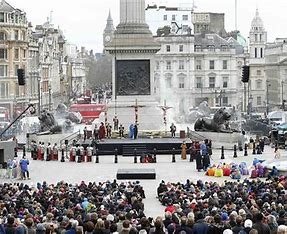Every year, Christians all around the world observe Good Friday, a solemn day commemorating Jesus Christ’s crucifixion. In Christian theology, this day is highly significant as it symbolizes the end of Jesus’ earthly ministry and the sacrifice he made to save humanity.
Passion Plays, which vividly portray the events leading up to Jesus’ crucifixion, emerge as a potent medium in conjunction with this observance. These plays help Christians gain a deeper comprehension of the Easter story and its lasting significance through dramatic performances and reenactments.
Good Friday occurs on the Friday before Easter Sunday and is an important element of Holy Week—the period preceding Easter. It is a day of serious contemplation, prayer, and recollection for Christians. The Gospel accounts of Jesus’ crucifixion point to the apex of God’s redemptive plan for humanity. Christian doctrine holds that Jesus willingly endured unspeakable pain and death on the cross to atone for humanity’s sins and provide salvation to everyone who believes in him.
Many Christians attend solemn services on Good Friday, where Scripture readings, hymns, and prayers recount the events leading up to Jesus’ betrayal, trial, execution, and burial. Churches often hold periods of silence and reflection to help believers contemplate the great sacrifice made by Jesus and the depth of God’s love for all people. There is an atmosphere of reverence and gratitude as Christians recognize the significance of Jesus’ death on the cross for their own lives.
Passion plays have a rich history that began in the Middle Ages as a means of instruction and religious observance. The last moments of Jesus’ life are portrayed in these theatrical plays, from his arrival in Jerusalem to his crucifixion and resurrection. Passion plays come in a variety of sizes and forms, from intimate neighborhood shows to expansive theatrical events that draw throngs of people.
The Oberammergau Passion Play is a highly renowned Passion Play that takes place in the German Bavarian village of Oberammergau once every ten years. The performance dates back to 1634 and began as a community promise to periodically enact the Passion of Christ in exchange for protection from the plague. The hundreds of performers, lavish sets, and costumes of the Oberammergau Passion Play continue to attract pilgrims and tourists from all over the world.

Passion Plays serve multiple purposes within Christian communities. They provide a visual and emotional portrayal of the Easter story, bringing its characters and events to life in a compelling manner. Through live performances, audiences are immersed in the narrative, experiencing the emotional weight of Jesus’ suffering and the triumph of his resurrection. Passion Plays also serve as a means of evangelism, reaching out to both believers and non-believers with the message of Christ’s love and redemption.
Each station of the Cross holds its own significance and helps Catholics reflect on different aspects of Jesus’ journey to the cross. Here’s a brief overview of the significance of each station:
1. Jesus is condemned to death: This station represents Jesus’ unjust condemnation by Pontius Pilate and highlights the theme of unjust suffering and the importance of standing up for truth and justice.
2. Jesus carries his cross: This station symbolizes Jesus’ acceptance of his cross and his willingness to carry the burden of humanity’s sins. It teaches the importance of embracing our own crosses and following Jesus’ example.
3. Jesus falls the first time: This station reminds us of Jesus’ humanity and vulnerability as he stumbles under the weight of the cross. It encourages us to find strength in our own moments of weakness and to seek help from others.
4. Jesus meets his mother: This station focuses on the emotional encounter between Jesus and his mother, Mary. It highlights the deep bond between them and the profound sorrow they both experienced during Jesus’ Passion.
5. Simon of Cyrene helps Jesus carry the cross: This station emphasizes the importance of community and support. It reminds us that we can help others carry their burdens and share in their struggles, just as Simon did for Jesus.
6. Veronica wipes the face of Jesus: This station highlights the compassionate act of Veronica, who wiped Jesus’ face with her veil. It encourages us to show kindness and compassion to others, even in the midst of suffering.
7. Jesus falls the second time: This station underscores the physical and emotional exhaustion that Jesus endured on his journey to Calvary. It reminds us that even in moments of repeated setbacks, we can find the strength to persevere.
8. Jesus meets the women of Jerusalem: This station focuses on Jesus’ interaction with the women who mourned for him along the way. It teaches us the importance of empathy and compassion for those who suffer.
9. Jesus falls the third time: This station emphasizes Jesus’ ultimate sacrifice and his determination to complete his mission despite immense suffering. It inspires us to find courage and resilience in the face of adversity.
10. Jesus is stripped of his garments: This station represents the humiliation and vulnerability of Jesus as his clothes are taken away. It reminds us of the importance of humility and letting go of worldly attachments.
11. Jesus is nailed to the cross: This station depicts the crucifixion of Jesus, highlighting the immense pain and sacrifice he endured for the salvation of humanity.
12. Jesus dies on the cross: This station marks the moment of Jesus’ death on the cross. It represents the ultimate sacrifice and redemption for humanity’s sins. It reminds us of the depth of God’s love and the hope for eternal life.
13. Jesus is taken down from the cross: This station portrays the tender moment when Jesus’ body is taken down from the cross and placed in the arms of his mother, Mary. It reflects the sorrow and grief of those who loved him and serves as a reminder of the importance of honoring and caring for the deceased.
14. Jesus is laid in the tomb: This final station represents the burial of Jesus. It symbolizes the culmination of his earthly journey and the anticipation of his resurrection. It invites us to reflect on the mystery of death and the hope of new life.

For Christians, Passion Plays and Good Friday are extremely important occasions that serve as potent reminders of the core beliefs of their religion. Believers engage in a profound act of devotion by recalling Jesus’ atoning death and how it altered the course of human history on Good Friday. Christians gain deeper insight into the Easter story and its relevance to their lives today by participating in Passion Plays as viewers or performers.
Furthermore, Passion Plays and Good Friday provide Christians with a chance to pause and consider their own religious journeys and dedication to following Christ. They are prompted to reflect on their own lives in light of Jesus’ teachings and example as they witness the events of his passion and death. Many people find that after reflecting for a while, they are filled with a fresh sense of gratitude, repentance, and determination to follow Jesus’ example of love, compassion, and forgiveness.
Sources




